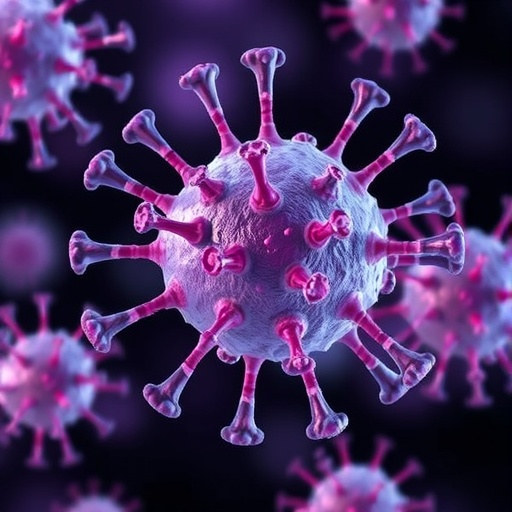In a groundbreaking discovery that redefines our understanding of bacterial immunity, scientists have uncovered a remarkable mechanism through which bacteria detect and defend themselves against invading bacteriophages. This newly described immune pathway hinges on TIR-domain-containing proteins in bacteria that sense the presence of phage capsids, triggering a robust antiviral response. The insights gained from this research illuminate not only the intricacies of microbial warfare but also open promising avenues for biotechnology and antimicrobial strategies.
Bacteriophages, the viruses that infect bacteria, are among the most abundant biological entities on Earth. Their evolutionary arms race with bacterial hosts has driven the development of sophisticated bacterial defense systems, including the well-known CRISPR-Cas immunity. However, the mechanisms by which bacteria recognize invading phage particles before infection remain scantily understood. The recent study sheds light on this critical early detection, revealing that bacterial TIR-domain immune proteins act as sensors for the phage capsid—the protein shell safeguarding viral genetic material.
The bacterial TIR (Toll/interleukin-1 receptor) domain proteins are evolutionary relatives of analogous domains found in mammalian innate immune receptors, known for their pivotal role in sensing pathogen-associated molecular patterns. This conservation across life domains suggests a primordial and universal function for TIR domains in immune surveillance. The team demonstrated that bacterial TIR proteins bind directly to phage capsid components, an interaction that serves as the initial alarm, activating downstream defense cascades to neutralize the threat.
Experimental evidence was gathered through a combination of genetic, biochemical, and imaging approaches, revealing that upon phage encounter, the TIR-domain sensor proteins undergo conformational changes that enable them to interact with intracellular signaling partners. This interaction instigates defense responses, including the production of toxic molecules that halt phage replication or the induction of programmed cell death to limit viral propagation to neighboring cells. Such suicide mechanisms, while detrimental to individual bacteria, protect the broader bacterial community from widespread infection.
Crucially, the study unveiled that the recognition process is exquisitely specific, with certain TIR-family proteins tuned to detect structural motifs unique to the phage capsid. This specificity ensures minimal cross-reactivity with the bacterial host and allows the bacteria to rapidly and accurately distinguish friend from foe. This molecular precision underscores the sophistication of bacterial immune systems, which operate under intense selective pressure from rapidly evolving viral adversaries.
Analyzing the evolutionary lineage of these TIR-domain proteins among diverse bacterial species, the authors posited that the capsid-sensing immune strategy is a conserved and widespread bacterial defense mechanism. The prevalence of this system across phylogenetically distinct bacteria hints at a fundamental role in microbial ecology, influencing bacterial population dynamics and ecosystem stability by curbing phage outbreaks.
The interaction between bacterial TIR sensors and phage capsids also has profound implications for synthetic biology and phage therapy. By harnessing or mimicking these natural immune interactions, researchers could engineer bacteria with enhanced resistance to phages or design phage variants capable of evading bacterial defenses. This dual potential is particularly relevant in the context of antibiotic resistance, where phage therapy is an emerging alternative treatment, necessitating precise control over bacterial-phage interactions.
From a structural biology standpoint, the study offers valuable templates for drug discovery. Detailed characterization of TIR-capsid binding interfaces could inform the design of molecules that modulate bacterial immunity, either boosting it to combat phage infections or dampening it to facilitate therapeutic phage applications. Understanding these molecular interactions enriches our toolkit for manipulating microbial systems in medicine and industry.
Moreover, the identification of the bacterial TIR-based capsid sensors broadens the conceptual framework of innate immune sensing beyond eukaryotes, suggesting convergent evolution or an ancient origin of immune recognition strategies. The revelation that bacteria possess dedicated detectors for viral structural elements prior to genetic material entry disrupts previous paradigms that primarily considered post-infection responses.
In terms of methodological innovation, the researchers employed state-of-the-art cryo-electron microscopy and single-molecule fluorescence techniques to visualize the TIR-phage capsid engagement in real-time and near-atomic resolution. These sophisticated tools allowed unprecedented insights into the dynamic process of immune recognition, providing both structural snapshots and kinetic data critical for comprehending the activation mechanisms.
The interplay between bacterial TIR proteins and phage components also emerged as a potential target for evolutionary manipulation. Phages could theoretically evolve altered capsid structures to evade detection, driving reciprocal adaptations in bacterial TIR sensors. This evolutionary tug-of-war underscores the complexity of molecular interactions in microbial ecosystems and challenges researchers to consider co-evolutionary processes in therapeutic design.
Through meticulous genetic manipulation, the study demonstrated that deletion or mutation of TIR-domain genes rendered bacterial strains more vulnerable to phage infection, confirming their indispensable role in phage immunity. These functional studies solidify the causal link between capsid detection and defensive outcomes, transforming correlative observations into definitive evidence.
Beyond defense, the activation of bacterial TIR systems may influence other physiological pathways, such as stress responses and metabolic regulation, linking immunity to broader cellular functions. Future research might elucidate these cross-pathway connections, enhancing our understanding of bacterial survival strategies in hostile environments.
The implications of these findings extend into environmental microbiology, where bacterial-phage interactions shape nutrient cycles, population balances, and microbial community structures in natural habitats. Recognizing how bacteria detect phages at the capsid level adds a new dimension to ecological models, potentially informing predictions about microbial resilience and ecosystem health under changing environmental conditions.
Finally, this discovery paves the way for exploring whether similar capsid-sensing mechanisms exist in archaea or even viruses themselves, hinting at a universal biological principle of early viral detection. Such investigations could reveal novel immunological paradigms and expand our comprehension of virus-host dynamics across the tree of life.
Subject of Research: Bacterial immune systems and their recognition of phage capsid proteins leading to immune activation.
Article Title: Bacterial TIR-based immune systems sense phage capsids to initiate defense.
Article References:
Roberts, C.G., Fishman, C.B., Zhang, Z. et al. Bacterial TIR-based immune systems sense phage capsids to initiate defense. Nat Microbiol (2025). https://doi.org/10.1038/s41564-025-02150-0
Image Credits: AI Generated




